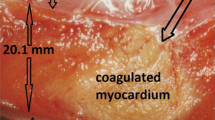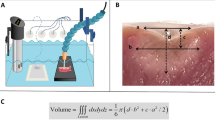Abstract
Purpose
Catheter–tissue contact force (CF) is a major determinant for radiofrequency (RF) ablation lesion size and quality. We sought to test the influence of catheter CF on lesion formation by using an open-irrigated electrode-laser mapping and ablation (ELMA) catheter.
Methods
With the ELMA catheter in a stable vertical position, continuous wave 1064 nm laser impacts at 15 W (9.5 W/mm2), 30 s (285 J/mm2), irrigation flow 30 mL/min, were aimed at the endocardial surface of bovine myocardium in heparinized stagnant blood (ACT >350 s) at room temperature (18 °C). Lesions were produced with CFs of 100 g, 10 g, in contact but without pressure, with the catheter tip 2.0 mm, and 5.0 mm away (n = 10, each). Lesions were evaluated morphometrically and were compared by the unpaired t tests.
Results
There were no significant differences between volumes of lesions achieved with catheter–tissue CF of 100 g, 10 g, and in contact without pressure: 297 ± 56.0 vs. 300 ± 39 vs. 320 ± 24, respectively (p > 0.05). However, volumes of lesions produced at a distance of 2 mm (95 ± 14 mm3) were significantly smaller (p < 0.0001), whereas at a distance of 5.0 mm, no lesions were produced. No steam-pop with crater or thrombus formation occurred.
Conclusions
By using an open-irrigated ELMA catheter, catheter–tissue CF is not a determinant for laser ablation lesion size and quality. Maximum sizes of lesions can be achieved with the catheter in intimate endocardial contact without pressure. However, lesions can be produced also at a catheter–tissue distance of 2.0 mm. Noticeably, there is no thrombus formation during laser application with the free floating ELMA catheter in the stagnant blood.



Similar content being viewed by others
References
Okumura, Y., Johnson, S. B., Bunch, T. J., Henz, B. D., O'Brien, C. J., & Packer, D. L. (2008). A systematical analysis of in vivo contact force on virtual catheter tip/tissue surface contact during cardiac mapping and intervention. Journal of Cardiovascular Electrophysiology, 19, 632–640.
Shah, D. C., Lambert, H., Nakagawa, H., Langenkamp, A., Aeby, N., & Leo, G. (2010). Area under the real-time contact force curve (force-time integral) predicts radiofrequency lesion size in an in vitro contractile model. Journal of Cardiovascular Electrophysiology, 21, 1038–1043.
Sacher, F., Wright, M., Derval, N., Denis, A., Ramoul, K., Roten, L., et al. (2013). Endocardial versus epicardial ventricular radiofrequency ablation. Utility of in vivo contact force assessment. Circulation. Arrhythmia and Electrophysiology, 6, 144–150.
Yokoyama, K., Nakagawa, H., Shah, D. C., Lambert, H., Leo, G., Aeby, N., et al. (2008). Novel contact force sensor incorporated in irrigated radiofrequency ablation catheter predicts lesion size and incidence of steam pop and thrombus. Circulation. Arrhythmia and Electrophysiology, 1, 354–362.
Di Biase, L., Natale, A., Barrett, C., Tan, C., Elayi, C. S., Ching, C. K., et al. (2009). Relationship between catheter force, lesion characteristics, “Poping”, and char formation: experience with robotic navigation system. Journal of Cardiovascular Electrophysiology, 20, 436–440.
Kumar, S., Morton, J. B., Lee, J., Halloran, K., Spence, S. J., Gorelik, A., et al. (2012). Prospective characterization of catheter-tissue contact force at different anatomic sites during antral pulmonary vein isolation. Circulation. Arrhythmia and Electrophysiology, 5, 1124–1129.
Reddy, V. Y., Shah, D., Kautzner, J., Schmidt, B., Saoudi, N., Herrera, C., et al. (2012). The relationship between contact force and clinical outcome during radiofrequency catheter ablation of atrial fibrillation in the TOCCATA study. Heart Rhythm, 9(11), 1789–1795.
Neuzil, P., Reddy, V. Y., Kautzner, J., Petru, J., Wichterle, D., Shah, D., et al. (2013). Electrical reconnections after pulmonary vein isolation is contingent on contact force during initial treatment. Results from the EFFICAS I Study. Circulation. Arrhythmia and Electrophysiology, 6, 327–333.
Nakagawa, H., Kautzner, J., Natale, A., Peichl, P., Cihak, R., Wichterle, D., et al. (2013). Locations of high contact force during left atrial mapping in atrial fibrillation patients. Electrogram amplitude and impedance are poor predictors of electrode-tissue contact force for ablation of atrial fibrillation. Circulation. Arrhythmia and Electrophysiology, 6, 746–753.
Tilz, R. R., Makimoto, H., Lin, T., Rilling, A., Metzner, A., Mathew, S., et al. (2014). In vivo left-ventricular contact force analysis: comparison of antegrade transseptal with retrograde transaortic mapping strategies and correlation of impedance and electrical amplitude with contact force. Europace, 16, 1387–1395.
Weber, H., & Sagerer-Gerhardt, M. (2013). Open-irrigated laser catheter ablation produces flow dependent sizes of lesions. Pacing and Clinical Electrophysiology, 36, 1132–1137.
Weber, H., & Sagerer-Gerhardt, M. (2014). Open-irrigated laser catheter ablation: influence of catheter irrigation and of contact and noncontact mode of laser application on lesion formation in bovine myocardium. Lasers in Medical Science, 29, 1183–1187.
Weber, H., Heinze, A., Enders, S., Hauptmann, G., Ruprecht, L., & Unsoeld, E. (1997). In vivo temperature measurement during transcatheter endomyocardial Nd:YAG laser irradiation. Lasers in Medical Science, 12, 352–356.
Fisher, J. C. (1993). Photons, physiatrics, and physicians: a practical guide to understanding interaction of laser light with living tissue: Part II: basic mechanisms of tissue destruction by laser beams. Journal of Clinical Laser Medicine and Surgery, 11, 291–303.
Knappe, V., Frank, F., & Rhode, E. (2001). Principles of lasers and biophotonic effects. Photomedicine and Laser Surgery, 22, 411–417.
Boulnois, J.-L. (1986). Photophysical processes in recent medical laser developments: a review. Lasers in Medical Science, 1, 47–66.
Bruneval, P., Mesnildrey, P., & Camilleri, P. (1987). Nd:YAG laser induced injury in dog myocardium: optical and ultrastructural study of early lesions. European Heart Journal, 8, 785–792.
He, D. S. H., Sharma, P., Wang, H. Z., Bosnos, M., & Marcus, F. I. (1999). Bio-battery signal predicts myocardial lesion formation and depth in vivo. Journal of Interventional Cardiac Electrophysiology, 1, 69–77.
Haines, D. (2004). Biophysics of ablation: application to technology. Journal of Cardiovascular Electrophsiology, 15, S2–S11.
Soejima, K., Stevenson, W. G., Sapp, J. L., Selwyn, A. P., Couper, G., & Epstein, L. M. (2004). Endocardial and epicardial radiofrequency ablation of ventricular tachycardia associated with dilated cardiomyopathy: the importance of low-voltage scars. Journal of the American College of Cardiology, 43, 1834–1842.
Maury, P., Leoabon, B., Duparc, A., Delay, M., & Galiner, M. (2007). Epicardial catheter ablation of ventricular tachycardia using surgical subxyphoid approach. Europace, 9, 212–215.
Garcia, F. C., Bazan, V., Zado, E. S., Ren, J. F., & Marchlinski, F. E. (2009). Epicardial substrate and outcome with epicardial ablation of ventricular tachycardia in arrhythmogenic right ventricular cardiomyopathy/dysplasia. Circulation, 120, 366–375.
Kosmidou, I., Inada, K., Seiler, J., Koplan, B., Stevenson, W. G., & Tedrow, U. B. (2011). Role of repeat procedures for catheter ablation of postinfarction ventricular tachycardia. Heart Rhythm, 8, 1516–1522.
Dagres, N., Cantu, F., Geelen, P., Lewalter, T., Proclemer, A., & Blomstrom-Lundqvist, C. (2012). Current practice of ventricular tachycardia ablation in patients with implantable cardioverter-defibrillators. Europace, 14, 135–137.
Vergara, P., Maisano, F., Maccabelli, G., & Della Bella, P. (2013). Radiofrequency and cryoenergy endo-epicardial catheter and surgical approach for a case of incessant ventricular tachycardia ablation. Europace, 15, 540.
Perna, F., Heist, E. K., Danik, S. B., Barett, C. D., Ruskin, J. N., & Mansour, M. (2011). Assessment of catheter tip contact force resulting in cardiac perforation in swine atria using sensing technology. Circulation. Arrhythmia and Electrophysiology, 4, 218–224.
Makimoto, H., Lin, T., Rillig, A., Metzner, A., Wohlmuth, P., Arya, A., et al. (2014). In vivo contact force analysis and correlation with tissue impedance during left atrial mapping and catheter ablation of atrial fibrillation. Circulation. Arrhythmia and Electrophysiology, 7, 46–54.
Nakagawa, H., Kautzner, J., Natale, A., Peichl, P., Cihak, R., & Wichterle, D. (2013). Location of high contact force during left atrial mapping in atrial fibrillation patients. Circulation. Arrhythmia and Electrophysiology, 6, 746–753.
Wang, P. J., Homoud, M. K., Link, M. S., & Estes, M. (1999). Alternative energy sources for catheter ablation. Current Cardiology Reports, 1, 165–171.
Weber, H., & Sagerer-Gerhardt, M. (2014). Open-irrigated laser catheter ablation: relationship between the level of energy, myocardial thickness, and collateral damages in a dog model. Europace, 16, 142–148.
Weber, H., & Sagerer-Gerhardt, M. (2014). Electrocardiographic monitoring of myocardial lesion formation during laser catheter ablation in a dog model. Innovations in Cardiac Rhythm Management , 5, 1641–1649.
Weber, H., & Sagerer-Gerhardt, M. (2015). Monitoring of laser effects on the conduction system by using an open-irrigated electrode-laser mapping and ablation catheter; laser catheter mapping. Europace.
Acknowledgments
This study was supported in part by the LasCor GmbH, Laser—Medical Devices, Taufkirchen, and Manufacturer of the open-irrigated ELMA catheter RytmoLas. Dr. M. Sagerer-Gerhardt is CTO and Dr. H. Weber is CEO of the LasCor Company, without any financial benefit from the company. Both the authors have full control of all primary data and both agree to allow the journal to review their data if requested.
Author information
Authors and Affiliations
Corresponding author
Rights and permissions
About this article
Cite this article
Sagerer-Gerhardt, M., Weber, H.P. Open-irrigated laser catheter ablation: influence of catheter–tissue contact force on lesion formation. J Interv Card Electrophysiol 42, 77–81 (2015). https://doi.org/10.1007/s10840-015-9977-4
Received:
Accepted:
Published:
Issue Date:
DOI: https://doi.org/10.1007/s10840-015-9977-4




